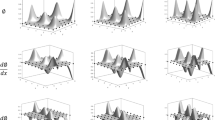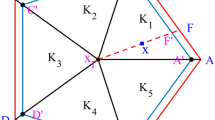Abstract
In this paper, a meshless local maximum-entropy finite element method (LME-FEM) is proposed to solve 1D Poisson equation and steady state convection–diffusion problems at various Peclet numbers in both 1D and 2D. By using local maximum-entropy (LME) approximation scheme to construct the element shape functions in the formulation of finite element method (FEM), additional nodes can be introduced within element without any mesh refinement to increase the accuracy of numerical approximation of unknown function, which procedure is similar to conventional p-refinement but without increasing the element connectivity to avoid the high conditioning matrix. The resulted LME-FEM preserves several significant characteristics of conventional FEM such as Kronecker-delta property on element vertices, partition of unity of shape function and exact reproduction of constant and linear functions. Furthermore, according to the essential properties of LME approximation scheme, nodes can be introduced in an arbitrary way and the \(C^0\) continuity of the shape function along element edge is kept at the same time. No transition element is needed to connect elements of different orders. The property of arbitrary local refinement makes LME-FEM be a numerical method that can adaptively solve the numerical solutions of various problems where troublesome local mesh refinement is in general necessary to obtain reasonable solutions. Several numerical examples with dramatically varying solutions are presented to test the capability of the current method. The numerical results show that LME-FEM can obtain much better and stable solutions than conventional FEM with linear element.














Similar content being viewed by others
References
Almeida RC, Silva RS (1997) A stable Petrov–Galerkin method for convection-dominated problems. Comput Methods Appl Mech Eng 140(34):291–304
Arroyo M, Ortiz M (2006) Local maximum-entropy approximation schemes: a seamless bridge between finite elements and meshfree methods. Int J Numer Methods Eng 65(13):2167–2202
Atluri SN, Zhu T (1998) A new meshless local Petrov–Galerkin (MLPG) approach in computational mechanics. Comput Mech 22(2):117–127
Atluri SN, Kim HG, Cho JY (1999) A critical assessment of the truly meshless local Petrov–Galerkin (MLPG), and local boundary integral equation (LBIE) methods. Comput Mech 24(5):348–372
Belytschko T, Lu YY, Gu L (1994) Element-free Galerkin methods. Int J Numer Methods Eng 37(2):229–256, times Cited: 2023
Belytschko T, Organ D, Krongauz Y (1995) A coupled finite element-element-free Galerkin method. Comput Mech 17(3):186–195
Belytschko T, Krongauz Y, Organ D, Fleming M, Krysl P (1996) Meshless methods: an overview and recent developments. Comput Methods Appl Mech Eng 139(1):3–47
Brooks AN, Hughes TJR (1982) Streamline upwind Petrov–Galerkin formulations for convection dominated flows with particular emphasis on the incompressible Navier–Stokes equations. Comput Methods Appl Mech Eng 32(1–3):199–259
Cyron CJ, Arroyo M, Ortiz M (2009) Smooth, second order, non-negative meshfree approximants selected by maximum entropy. Int J Numer Methods Eng 79(13):1605–1632
Dunavant DA (1985) High degree efficient symmetrical Gaussian quadrature rules for the triangle. Int J Numer Methods Eng 21(6):1129–1148
Gu YT, Liu GR (2001) A coupled element free Galerkin/boundary element method for stress analysis of two-dimensional solids. Comput Methods Appl Mech Eng 190(34):4405–4419
Hegen D (1996) Element-free Galerkin methods in combination with finite element approaches. Comput Methods Appl Mech Eng 135(12):143–166
Huerta A, Fernández-Méndez S (2000) Enrichment and coupling of the finite element and meshless methods. Int J Numer Methods Eng 48(11):1615–1636
Liu GR, Gu YT (2000) Meshless local Petrov–Galerkin (MLPG) method in combination with finite element and boundary element approaches. Comput Mech 26(6):536–546
Liu WK, Jun S, Zhang YF (1995) Reproducing kernel particle methods. Int J Numer Methods Fluids 20(8–9):1081–1106
Rockafellar RT (1970) Convex analysis. Princeton University Press, Princeton
Rosolen A, Millan D, Arroyo M (2010) On the optimum support size in meshfree methods: a variational adaptivity approach with maximum-entropy approximants. Int J Numer Methods Eng 82(7):868–895
Shannon CE (2001) A mathematical theory of communication. SIGMOBILE Mob Comput Commun Rev 5(1):3–55
Sukumar N (2004) Construction of polygonal interpolants: a maximum entropy approach. Int J Numer Methods Eng 61(12):2159–2181
Sukumar N, Wright RW (2007) Overview and construction of meshfree basis functions: from moving least squares to entropy approximants. Int J Numer Methods Eng 70(2):181–205
Versteeg HK, Malalasekera W (2007) An introduction to computational fluid dynamics: the finite Volume method, 2nd edn. Prentice Hall, Upper Saddle River
Wu CT, Hu W (2011) Meshfree-enriched simplex elements with strain smoothing for the finite element analysis of compressible and nearly incompressible solids. Comput Methods Appl Mech Eng 200(4546):2991–3010
Wu CT, Park CK, Chen JS (2011a) A generalized approximation for the meshfree analysis of solids. Int J Numer Methods Eng 85(6):693–722
Wu CT, Yang FL, Young DL (2011b) Application of the method of fundamental solutions and the generalized Lagally theorem to the interaction of solid body and external singularities in an inviscid fluid. Comput Mater Continua 23(2): 135 –154
Wu CT, Hu W, Chen JS (2012) A meshfree-enriched finite element method for compressible and near-incompressible elasticity. Int J Numer Methods Eng 90(7):882–914
Young DL, Jane SC, Lin CY, Chiu CL, Chen KC (2004) Solutions of 2D and 3D Stokes laws using multiquadrics method. Eng Anal Bound Elem 28(10):1233–1243
Zienkiewicz OC, De SR, Gago JP, Kelly DW (1983) The hierarchical concept in finite element analysis. Comput Struct 16(14):53–65
Zienkiewicz OC, Taylor RL, Zhu J (2005) The finite element method: its basis and fundamentals, 6th edn. Butterworth-Heinemann, Oxford
Author information
Authors and Affiliations
Corresponding author
Rights and permissions
About this article
Cite this article
Wu, C.T., Young, D.L. & Hong, H.K. Adaptive meshless local maximum-entropy finite element method for convection–diffusion problems. Comput Mech 53, 189–200 (2014). https://doi.org/10.1007/s00466-013-0901-4
Received:
Accepted:
Published:
Issue Date:
DOI: https://doi.org/10.1007/s00466-013-0901-4




